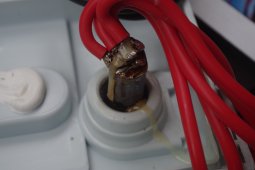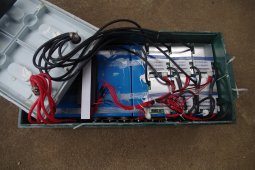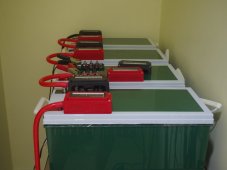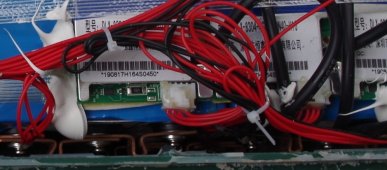Chris Down Under
New Member
Hi everyone,
Newbie here, but have been off grid since 2009. As part of the regular checks of the system I noticed that the battery terminals for my Pro Power 12V 306Ah LiFePO4 batteries were running hot - hot enough that you would burn your fingers if you left them there for a few minutes. Four of them are connected in series so as to power a 48V inverter. The maximum charge current from the solar panels is around 110A, but rarely are the batteries receiving such charge. Having been off grid a long time the batteries are rarely drawn down 20%, so most mornings they're more than 80% full - every day. I've used these batteries for about three years now and they are out of warranty. They still work, but the terminals are hot whilst the current for either charge or discharge is beyond 60A.
Being something of an old school tech geek, I cracked the case open so as to see what was going on inside causing the hot terminals.
Here's what I found:

I never in my wildest dreams expected to see six 10AWG (6mm2) wires soldered onto the bottom of the battery terminal. And observant readers will note that the drizzle of glue indicates that the epoxy got hot enough that the terminal has now rotated. All very exciting stuff, and not something you'd want to see. The plan at this stage is to drill a hole in the top of the battery case, cut the wires, pull them through, lug them properly with M8 lugs and connect the lot to a 300A rated bus bar which will be attached to the lid of the battery. Not pretty, but it should work and the buss bar has 4x M8 lugs so that should spread the current a lot better.
The combination of metals in the current arrangement is probably bonkers. And soldering... Yikes!
I'm curious to hear if any of the readers have any thoughts as to this fix.
The inside of the battery surprised me too because it is a 6P/4S configuration and there are no less than six BMS systems inside the battery. You can count them. I really never expected to find this. Oh well. Here's a photo of the guts of the thing.

At this stage, I will retire these batteries and use them in a less demanding system than the house power system. If anyone can recommend replacement 48V around 400A batteries I'd be appreciative. I like the look of the 100A rack mount batteries.
Thanks, and I'd appreciate any and all thoughts in this matter.
Cheers
Chris
Newbie here, but have been off grid since 2009. As part of the regular checks of the system I noticed that the battery terminals for my Pro Power 12V 306Ah LiFePO4 batteries were running hot - hot enough that you would burn your fingers if you left them there for a few minutes. Four of them are connected in series so as to power a 48V inverter. The maximum charge current from the solar panels is around 110A, but rarely are the batteries receiving such charge. Having been off grid a long time the batteries are rarely drawn down 20%, so most mornings they're more than 80% full - every day. I've used these batteries for about three years now and they are out of warranty. They still work, but the terminals are hot whilst the current for either charge or discharge is beyond 60A.
Being something of an old school tech geek, I cracked the case open so as to see what was going on inside causing the hot terminals.
Here's what I found:

I never in my wildest dreams expected to see six 10AWG (6mm2) wires soldered onto the bottom of the battery terminal. And observant readers will note that the drizzle of glue indicates that the epoxy got hot enough that the terminal has now rotated. All very exciting stuff, and not something you'd want to see. The plan at this stage is to drill a hole in the top of the battery case, cut the wires, pull them through, lug them properly with M8 lugs and connect the lot to a 300A rated bus bar which will be attached to the lid of the battery. Not pretty, but it should work and the buss bar has 4x M8 lugs so that should spread the current a lot better.
The combination of metals in the current arrangement is probably bonkers. And soldering... Yikes!
I'm curious to hear if any of the readers have any thoughts as to this fix.
The inside of the battery surprised me too because it is a 6P/4S configuration and there are no less than six BMS systems inside the battery. You can count them. I really never expected to find this. Oh well. Here's a photo of the guts of the thing.

At this stage, I will retire these batteries and use them in a less demanding system than the house power system. If anyone can recommend replacement 48V around 400A batteries I'd be appreciative. I like the look of the 100A rack mount batteries.
Thanks, and I'd appreciate any and all thoughts in this matter.
Cheers
Chris





